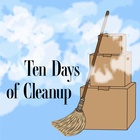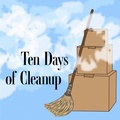Now that all the miscellaneous orange packages were out of my client’s storage container, I saw something large wrapped in blue. I removed some red packages that were resting on top of it and place them in one corner of the container. The blue package was long and felt metallic.
My daughter, Sycamore, stayed in the car, playing a game on her iPad as I tore at the paper. Inside was indeed something metal. In fact, three things. Pieces of what looked like a car grille.
I could have easily tossed this into a rubbish bin. But based on my last experience with items in the storage container, I felt a tug to do a little more digging.
I called my ex and Sycamore’s father, Stewart.
Stewart wasn’t my ex-husband, although we did talk about getting married. When I got pregnant with Sycamore, I thought that we should finally do it, but Stewart argued that a piece of paper from the government didn’t mean much. Stewart was a fine artist, a painter, who never wanted to compromise on his values. Foremost for him was to stay true to himself. I personally never saw much value in that.
For the next five years, we had become almost platonic roommates who shared parenting duties. We didn’t argue, but maybe we needed to. All passion was gone from our relationship, so when he told me a year and a half ago that he had fallen in love with a sound artist in the Arts District in Little Tokyo, I was not shocked. He moved in with her while I found a small apartment in Pasadena. It was a 500-square-foot cottage arranged around a shared courtyard. Before the pandemic, Sycamore regularly visited her father and his pregnant girlfriend. Did I say that life was a bit complicated for us?
I called Stewart about my latest discovery in the storage container because he loved cars. He sometimes was commissioned to even paint images on car hoods and trunks. He himself drove an old Chevy truck, big enough for transporting his art canvases.
I sat down on the cold concrete and Facetimed Stewart.
He immediately picked up. “Hey, I was thinking of you two. Sycamore okay?”
I heard a baby crying in the background and figured that was probably Stewart’s newborn, Benji.
Stewart said having a baby during lockdown was actually a blessing. He was enjoying fatherhood a second time and not having to travel to various gallery openings in multiple countries meant more father-son time. I pushed away a bit of resentment. Benji was getting something that had been denied to Sycamore when she was an infant.
I pointed my iPhone towards the pieces of metal.
“Interesting,” he responded. “It reminds me, kinda, of the Hirohata Merc.”
Stewart was Irish and sometimes I couldn’t understand everything he said.
“What? I thought you just said a Japanese name.”
“I did. The Hirohata. It’s the name of a custom car built in the 1950s. The man who commissioned it was named Bob Hirohata. Merc is short for Mercury.”
“You know a lot about something from before you were born.”
“Any car lover knows about the Hirohata Merc. Google it. There’s a documentary on it, too. By the Historic Vehicle Association.”
I didn’t have time to watch a documentary and pressed Stewart for a short summary.
“Okay, before the Merc, only very rich people could produce custom cars. It wasn’t what regular people did. But Hirohata was obviously into making something unique. He had come back from serving in the Navy and he was ready to drive around a special car on a regular basis.”
As we Facetimed, I found a photo of the Hirohata Merc on the Internet. The colors were minty green. I didn’t understand quite what the allure was, but culturally I did appreciate its streamlined appearance. There were no handles on the door, making the surface look smooth and seamless like a dolphin’s body.
Benji was starting to wail now and Stewart excused himself to change the baby’s diaper. “I’ll e-mail you a contact with the Historic Vehicle Association. Maybe they can help you out.”
It turned out that the organization was in Allentown, Pennsylvania. I wasn’t optimistic that anyone could help me from the East Coast. But I left a voicemail message on the number that Stewart had given me.
In around thirty minutes, I got a call from a local number.
“Hello, Souji RS, Hiroko speaking.”
“Ah, is this the woman who has some old car parts? We were contacted by the Historic Vehicle Association.”
I was shocked by the quick response. I told the man that I would text him a photo of what I had.
It only took a minute after I sent the photos that the man called me back.
“How much are you selling the parts for?”
“I’m giving it away. For anyone who will take it by tonight.”
Three masked older men came in about an hour. Before their arrival to the storage container, I took Sycamore back to our cottage and had our neighbor keep watch outside in a lawn chair.
“Great balls of fire,” one of the men said when I reopened the container.
The other attempted to whistle through his mask.
“It’s hard to get parts right now. Especially during the pandemic.”
“These are parts from three 1951 Fords. Just like the Hirohata Merc.”
“Maybe they were trying to make another one?” I said.
The three men laughed, as if what I was saying was ridiculous. Apparently there was one and only one Hirohata Merc.
“So you want it?”
“How much are you going to charge?” a man with an old pair of glasses asked.
“Nothing. As long as you take it now.”
I could feel the excitement between the three men. They explained that they had started getting into cars in high school. That had been almost forty years ago.
“The silver lining of the pandemic is that we’ve been working on our old cars again in our respective garages. When it starts to open up, it will be good to work on something together.”
They had brought canvases to wrap the metal parts and lifted them carefully in the bed of their truck.
“We really need to give you some money for this,” the man in the glasses said, stuffing a fresh hundred dollar bill in my hand. I had a feeling that the parts were worth much, much more, but it lifted my spirits to see their joy in receiving them.
After they left, I Facetimed Stewart and gave him an update on the fate of the car parts.
“You want to see Benji?” he asked after I was finished.
I actually had only seen still photos that Stewart had been texting to my phone.
“Sure.”
He was beautiful. He had an impish grin, most likely inherited from Stewart. I could instantly remember when Sycamore was about that age. She had enormous mochi-shaped cheeks and bright observant eyes. The fat cheeks had disappeared, but the watchful eyes had remained.
“I can’t wait until Sycamore gets to see and hold her baby brother,” Stewart said.
Surprisingly, I wasn’t resentful to hear that from Stewart. I actually was hopeful, happy that my daughter would not be alone if something happened to me. I thought about the camaraderie of the three men who had picked up the car grille—lifelong friends whose bond had survived the test of time.
Note: For more information about the real life Hirohata Merc, see the documentary, Hirohata Merc: Custom Legend, produced by the Historic Vehicle Association.
Also, the Japanese American National Museum is planning an exhibition on Japanese Americans and their cars. If you have photographs or home movies, please contact Kristen Hayashi, Director of Collections Management and Access, at collections@janm.org or 213.830.5712.
© 2021 Naomi Hirahara





